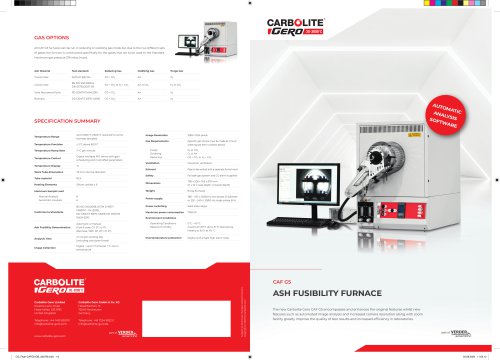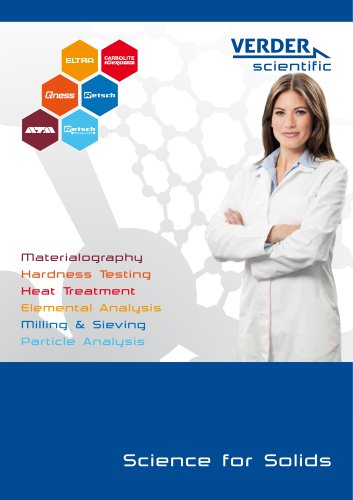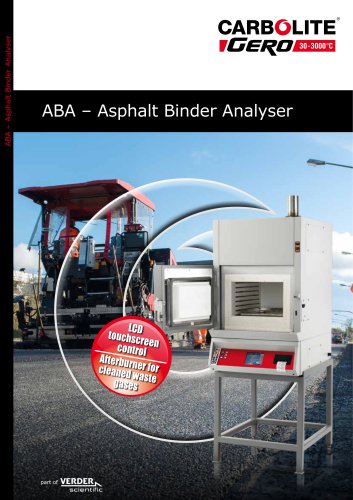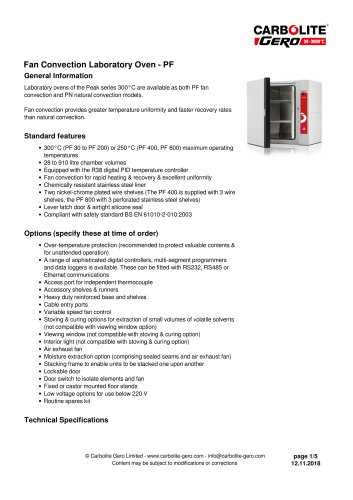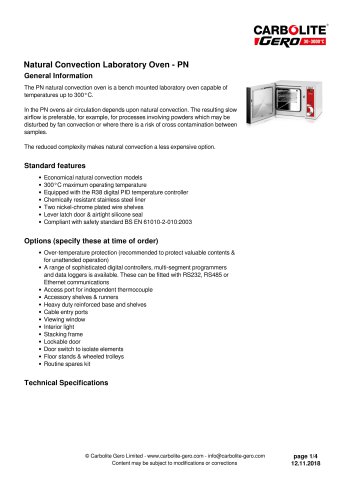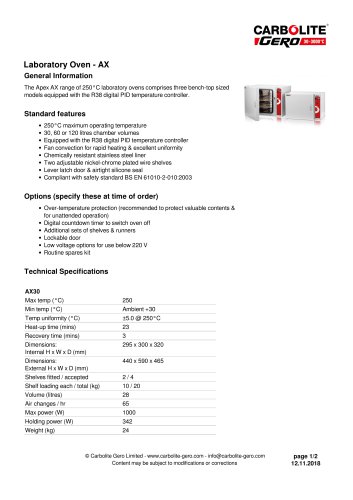 Website:
Carbolite Gero
Website:
Carbolite Gero
Group: VERDER Scientific
Catalog excerpts

Vacuum, Inert and Reactive Gas Furnaces up to 3000 °C
Open the catalog to page 1
As part of the VERDER Group, the business division VERDER SCIENTIFIC sets standards in the development, manufacture and sales of laboratory and analytical equipment. The instruments are used in the areas of quality control, research and development for sample preparation and analysis of solids.
Open the catalog to page 2
Leading Heat Technology Portfolio The foundation for a good project: Understanding With the formation of Carbolite Gero GmbH & Co. KG, customer requirements. The Carbolite Gero technical staff customers realizing heat-treatment processes from 30 °C consists of highly-qualified engineers, physicists and chemists to 3000 now have access to a single highly qualified °C with a strong theoretical background. They are true experts source for equipment. Carbolite Gero instruments work in the wide range of heat treatment applications up to with vacuum, partial pressure, air, controlled pressure,...
Open the catalog to page 3
Content Debinding, Annealing, Soldering and Tube Furnaces Debinding Furnace up to 150 °C Annealing Furnaces up to 1100 °C Soldering Tube Furnace up to 1050 °C Tube Furnaces up to 1350 °C Split Tube Furnaces up to 1300 °C Eight-zone Tube Furnace up to 1300 °C Model Page In this temperature range, tube furnaces or hot wall furnaces use MoSi2 heating elements for a maximum temperature of 1800 °C. All other furnaces are referred to as cold wall furnaces as they are equipped with a water cooled vessel. A maximum temperature of 3000 °C is possible. For each system, one important and popular...
Open the catalog to page 4
Special Furnaces and Options In this chapter, some special furnaces are described. The metal injection molding furnaces include solutions for the whole process chain of debinding and sintering. SERIE 3000 furnaces are based on the standard LHTG and HTK GR models, including options for pyrolysis and 3000 °C operation. At least some solutions for crystal growth as well as some customized heat treatment systems and their unique features for applications are briefly mentioned. Metal Injection Moulding (MIM) Furnaces Solutions for Debinding and Sintering Graphitization Furnaces SERIE 3000...
Open the catalog to page 5
Heat is generated by the averaged random movement of molecules, atoms and electrons. For example: temperature in a gas is caused by the Brownian movement of the molecules and atoms the gas consists of. The same is true for a liquid. The thermal movement of the electrons in a solid is the reason why a temperature measurement with thermocouples is possible. The standard thermocouples are from type K, N, S, R, B and C. They consist of wires from different materials, which are welded together at the tip. The highest temperatures up to 3000 are controlled by °C means of measuring the heat...
Open the catalog to page 6
Introduction Physics of Heat Some design and insulation principles In reality, all three heat transfer mechanisms are present at the same time. As a result, time consuming calculations and simulations are needed to design a furnace with outstanding temperature homogeneity. Carbolite Gero has accumulated decades of engineering experience creating exceptional heat treatment systems. Some important design principles are: Temperature distribution within a three zone furnace with insulation plugs fitted 2.5 outer tube diameter Uniform zone of temperature distribution Temperature distribution...
Open the catalog to page 7
Nowadays, many heat treatment processes are carried out in vacuum environment. For vacuum metallurgy, annealing, crystal growing, soldering and brazing and many more applications, vacuum technology must be combined with heat treatment. For this purpose, the samples have to be surrounded by a sealed device, such as a sealed working tube, a sealed retort or a sealed water cooled vessel. The most important advantage of the evacuation is the reduction of the Oxygen level to avoid the sample from oxidation. Besides, for heat treatment processes with a temperature above 1800 °C, the Oxygen level...
Open the catalog to page 8
CARBOLITEr/Tg^nr iv 'MVacuum Technology 09Vacuum pumps Turbomolecular pump Roots pump Rotary vane pump The turbomolecular pump consists of stators between several high speed rotors. The rotational speed is more than 10 000 turns per minute. At these speeds, the rotor is now in the range of the particle velocity enabling gas to be pushed through the pump. When combined with a pre-vacuum pump, the achievable vacuum level is in the high vacuum range or better. Turbomolecular pumps are the most convenient and frequently used pumps for high and ultra-high vacuum operation. Very high atmospheric...
Open the catalog to page 9
Temperature For heat treatment processes, the required operating temperature must first be established. By design, a resistance heated furnace is limited to its maximum temperature. Three main different insulating principles exist: Ceramic fibre insulation, metallic (Mo and W) radiation shields and graphite felt insulation. CrFeAl wires or MoSi2 U-shaped elements are two possible heating elements. Both ceramic fibre and graphite felt insulation have low heat conductance and are outstanding insulation materials. Both heating elements need an oxidizing atmosphere during heat treatment to...
Open the catalog to page 10
CARBGLITEr/Tg^nr iv 'MFurnace Selection Guide 11 Application matrix Application - not suited Debinding, Annealing, Soldering & Heating Tube Furnaces Model principle Page www.carbolite-gero.com | Leading Heat Technology
Open the catalog to page 11
Soldering Tube Furnace up to 1050 °C Split Tube Furnaces up to 1300 °C °C Eight-zone Tube Furnace up to 1300
Open the catalog to page 13
Debinding, Annealing, Soldering and Tube Furnaces 14 Furnace for catalytic debinding Metal injection moulding (MIM) and Ceramic injection moulding (CIM) is an expanding modern manufacturing technology. The MIM and CIM manufacturing processes are comprised of 4 steps: compounding raw material into feedstock, moulding feedstock to the desired shape creating a green part, debinding, and sintering. Debinding is the most demanding operation in this process. The debinding of Catamold® feedstock is performed catalytically with nitric acid. This process demands precise control of both the...
Open the catalog to page 14All Carbolite Gero catalogs and technical brochures
-
CAF G5
2 Pages
-
Overview - Ovens & Furnaaces
16 Pages
-
Materialography
20 Pages
-
PF
5 Pages
-
PN
4 Pages
-
AX
2 Pages
-
Furnaces for Precious Metals
4 Pages
-
Furnaces for Precious Metals
4 Pages
Archived catalogs
-
Verder Scientific Product News
16 Pages
-
LHT
6 Pages
-
RHZS - Rotating Tube Furnace
2 Pages
-
Verder Scientific
20 Pages
-
Furnaces & Ovens for Aerospace
12 Pages
-
Batch Heat Treatment Furnaces
8 Pages




